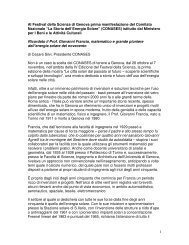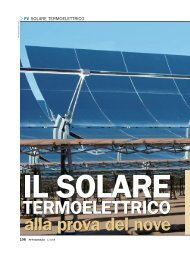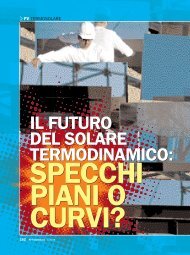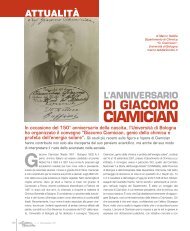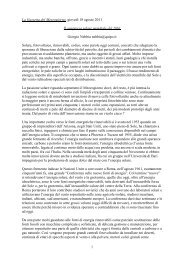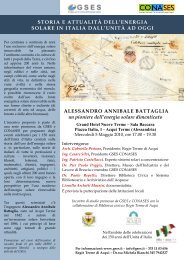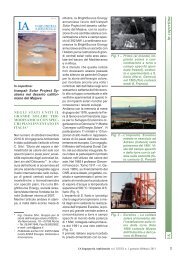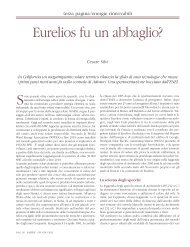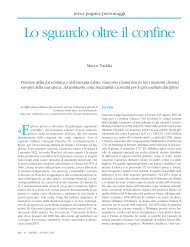FUELS FROM SOLAR ENERGY. A DREAM OF GIACOMO ... - GSES
FUELS FROM SOLAR ENERGY. A DREAM OF GIACOMO ... - GSES
FUELS FROM SOLAR ENERGY. A DREAM OF GIACOMO ... - GSES
You also want an ePaper? Increase the reach of your titles
YUMPU automatically turns print PDFs into web optimized ePapers that Google loves.
<strong>FUELS</strong> <strong>FROM</strong> <strong>SOLAR</strong> <strong>ENERGY</strong>.<br />
A <strong>DREAM</strong> <strong>OF</strong> <strong>GIACOMO</strong> CIAMICIAN, THE FATHER <strong>OF</strong> PHOTOCHEMISTRY<br />
Margherita Venturi<br />
Vincenzo Balzani<br />
Maria Teresa Gandolfi<br />
Dipartimento di Chimica “G. Ciamician”<br />
Via Selmi, 2 – 40126 Bologna (Italy)<br />
e-mail: margherita.venturi@unibo.it<br />
e-mail: vincenzo.balzani@unibo.it<br />
e-mail: mariateresa.gandolfi@unibo.it<br />
ABSTRACT<br />
Giacomo Ciamician was professor of Chemistry at the<br />
University of Bologna from 1889 to 1922. Inspired by the<br />
ability of plants to make use of solar energy, he was the<br />
first scientist to investigate the photochemical reactions in<br />
a systematic way, so that he is now considered a pioneer<br />
of modern photochemistry. In a famous address presented<br />
before the VIII International Congress of Applied<br />
Chemistry, held in New York in 1912, he strongly<br />
suggested to replace “fossil solar energy” (i.e, coal) with<br />
the energy that the earth receives from the sun every day.<br />
In particular, he forecasted the production of fuels by<br />
means of artificial photochemical reactions (artificial<br />
photosynthesis), which is still one of the most important<br />
goals of current research in the field of chemistry. The<br />
possibility of obtaining fuels (particularly dihydrogen)<br />
from solar energy would indeed solve two great problems<br />
of the present day society: energy and environment.<br />
thoughts on the energy problem are very close to those<br />
discussed in present days.<br />
Ciamician was born in Trieste in 1857 from an Armenian<br />
family. His career followed a quite linear “geographical“<br />
journey. After some years of study at the University of<br />
Wien, he received in 1880 his doctorate at the German<br />
University of Giessen and then went to Rome to work in<br />
the laboratory of one of the greatest Italian chemists,<br />
Stanislao Canizzaro. In 1887 Ciamician became professor<br />
of General Chemistry at the University of Padua, and two<br />
years later he moved to the University of Bologna, where<br />
he remained until the time of his death on January 2,<br />
1922.<br />
1. INTRODUCTION<br />
At the beginning of the new millennium, re-examination<br />
of the work of scientists who lived in between the XIX<br />
and XX centuries could be an exercise of curiosity that<br />
simply leads to loss of time. This is not the case if the<br />
scientist taken into consideration is Giacomo Ciamician<br />
(Fig. 1), since most of his work looks quite interesting<br />
and even useful for present-day research in the field of<br />
chemistry. On reading his scientific papers and the texts<br />
of his talks, we have been fascinated and, sometimes,<br />
even astonished, because his assertions and intuitions<br />
often appear to be inspired by a prophetic spirit. Almost<br />
one century ago, Giacomo Ciamician realized that<br />
Chemistry is a “central” science that permeates many<br />
other fields of knowledge, and that can play an essential<br />
role in solving the four greatest problems of humanity:<br />
food, health, energy, and environment. In particular, his<br />
Fig. 1: Autographed portrait that Giacomo Ciamician<br />
(1857 – 1922) presented to students who submitted<br />
perfect examination papers<br />
First published by the American Solar Energy Society in the Proceedings of the 2005 Solar World Congress<br />
Orlando, Florida USA - August 6-12, 2005
If the geographical journey of Ciamician was simple, his<br />
scientific activity was very rich and complex. Today<br />
Ciamician is mostly known for his contribution to the<br />
development of organic chemistry; for this reason since<br />
1979 the Division of Organic Chemistry of the Italian<br />
Chemical Society has established the Ciamician Award<br />
which is assigned to a young researcher every year.<br />
However, Ciamician was a scientist with multiple<br />
interests: he wrote about 400 papers covering various<br />
research fields, including emission spectroscopy, theory<br />
of electrolytic dissociation, chemistry of pyrrole, chemical<br />
action of light, and chemical reactions in green plants.<br />
Considering such a scientific production, it is easy to<br />
agree with the first sentence of one of the several papers<br />
dedicated to his memory (Fig. 2): “One of the most<br />
important human talents is for sure the ability of being<br />
interested in many fields and of increasing the knowledge<br />
in all of them. Giacomo Ciamician, pioneer of the<br />
Photochemistry, is the perfect example of this definition”<br />
(1).<br />
Fig. 2: The first page of the paper of M. Pfau and N.D.<br />
Heindel dedicated to Giacomo Ciamician<br />
Ciamician was also convinced that a scientist, worthy of<br />
this name, cannot live in an ivory tower, but must be<br />
deeply involved in the social life and engaged in the<br />
spreading of science.<br />
Ciamician social engagement is demonstrated by his long<br />
activity as a Senator of the Italian Kingdom; he was<br />
elected to the Senate in 1910 and maintained this position<br />
until the end of his life. During this period he served on<br />
many important commissions and gave several speeches<br />
in Senate on the problem of science and public education.<br />
In particular, he participated actively in the discussions on<br />
the budgets of public instruction, agriculture, industry and<br />
commerce, as well as on several other topics such as the<br />
application of international conventions and the<br />
modification of some laws. During the First World War<br />
he dedicated all his energy to solve problems of national<br />
defence: the strain connected to this activity undoubtedly<br />
hastened his premature death.<br />
To promote science, Ciamician delivered many public<br />
lectures on important themes related to the everyday life,<br />
such as: “Chemical Problems of the New Century”,<br />
“Problems and Objectives of Today’s Organic<br />
Chemistry”, “Cooperation of the Sciences”, and “Organic<br />
Chemistry in Organisms”.<br />
During his career Ciamician received several academic<br />
honours. In 1887, when he was still very young, he was<br />
awarded with the Prize of the Royal Academy of Lincei;<br />
later on, he became a member of this academy and of the<br />
Italian National Academy of XL; he also became a<br />
correspondent member of practically all the Italian<br />
academies, a foreign member of the scientific academies<br />
of France, Prussia, Bavaria and Sweden, and of the<br />
scientific societies of Göttingen and Upsala. He was a<br />
honorary member of the American Chemical Society as<br />
well as of the Chemical Societies of France, Germany,<br />
and London. The University of Glasgow conferred on him<br />
the honorary degree of Doctor of Laws. After the<br />
reorganization of the Italian Association of General and<br />
Applied Chemistry he was elected president of the<br />
Association. Ciamician was also proposed ten times for<br />
the Nobel Prize by famous Italian and foreign scientists,<br />
in particular twice by Emil Fischer, the greatest organic<br />
chemist of his time.<br />
Ciamician was not only a great investigator, but also<br />
equally great as a teacher. McPherson, who in 1913 had<br />
the privilege of visiting Ciamician’s laboratory and<br />
attending some of his lectures, said: “These lectures were<br />
ideal – exceedingly clear and logical. They were<br />
illustrated with numerous experiments skillfully<br />
performed. For one and one-half hours (the length of the<br />
lecture period) he poured his whole energy into this<br />
subject. At the end of his lecture he was received by an<br />
assistant with a heavy wrap – much as our modern<br />
football players who retire exhausted from the game” (2).<br />
2. CIAMICIAN PIONEER <strong>OF</strong> THE<br />
PHOTOCHEMISTRY<br />
Ciamician became aware of the great potential of the<br />
utilization of solar energy for chemical purposes during<br />
his studies on the chemistry of green plants. The problem<br />
of understanding the way in which plants produce the<br />
substances that are essential to their own life was dealt<br />
with in 21 papers written in collaboration with Ciro<br />
Ravenna. Ciamician was convinced that the plants are<br />
wonderful chemical industries and that, to learn how do<br />
they work, it is necessary to go deeper and deeper in their<br />
First published by the American Solar Energy Society in the Proceedings of the 2005 Solar World Congress<br />
Orlando, Florida USA - August 6-12, 2005
structure, from the tree to the leaves, to the cells, to the<br />
chloroplasts, to the grains, to the membranes, down to<br />
reach the molecular level.<br />
As Ciamician said in a famous address to the Italian<br />
Society for the Progress of Sciences (3), delivered some<br />
months before his death, his attention was particularly<br />
attracted by the following problem: “Why plants produce<br />
in such great number and variety substances that look<br />
unrelated to their lives? Everybody agrees that proteins,<br />
simple and complex sugars, fats and others substances,<br />
like lecithins, and some mineral substances are essential<br />
to plants, as they are for all living organisms. But what<br />
are the others, that we called accessories, used for? I<br />
mean, the substances like glucosides, alkaloids, some dyes<br />
(of course I am not referring to the coloured substances<br />
of the flowers and plants whose purpose is clear),<br />
terpenes, camphors, tannins, resins, and some others.<br />
All these substances seem to be unnecessary and<br />
accidental; all the animals do not contain such<br />
substances or they do in a little amount. We started from<br />
the concept that plants, because of their own nature, need<br />
more chemical stimuli than the animals do.<br />
The chemistry of plants is more complex because it has to<br />
supply for the lack of differentiation of structures and the<br />
absence of special organs. Such additional substances,<br />
especially the alkaloids, can be considered as vegetable<br />
hormones”.<br />
In his address, Ciamician also explained in details the<br />
experiments he did and the results he got; on closing, he<br />
said: “The conclusion is that plants make up for their<br />
organisation less differentiated than in the animals, and<br />
their wilful manifestations less expressed, by using a quite<br />
perfect chemistry. The conscience of plants is chemical in<br />
nature!”<br />
In systematic experiments Ciamician inoculated in the<br />
plants, or supplied to plants through their roots, organic<br />
substances pure or in solutions. He inoculated a substance<br />
(i.e, xanthine) and its methyl derivatives (theobromine,<br />
caffeine). Then he observed the toxic effect on the plant<br />
and other related reactions. He worked on hundreds of<br />
substances, with amazing results. He found, for instance,<br />
that some substances have a beneficial effect, while some<br />
others have a harmful action. These results were<br />
described by Ciamician in his admirable and suggestive<br />
talk entitled “The Photochemistry of the Future” that he<br />
delivered before the VIII International Congress of<br />
Applied Chemistry, held in New York in 1912 (4): “More<br />
recently while studying the function of the alkaloids in the<br />
plants, we have succeeded in modifying the production of<br />
nicotine in the tobacco plant, so as to obtain a large<br />
increase or a decrease in the quantity of this alkaloid. …<br />
In a series of experiments made in an effort to determine<br />
the physiologic function of the glucosides, we have<br />
succeeded in obtaining them from plants that usually do<br />
not produce them. We have been able, through suitable<br />
inoculations, to force maize to synthetize salicin”.<br />
It is easy to see in these results the first attempts to<br />
develop what nowadays we call biotechnology. Ciamician<br />
himself forecasted the development of this branch of<br />
science: “… modern industry is affiliated very intimately<br />
with pure science; the progress of one determines<br />
necessarily that of the other. … Modern interest is<br />
concentrated on the study of the organic chemistry of<br />
organisms. This new direction in the field of pure science<br />
is bound to have its effect on the technical world and to<br />
mark out new paths for the industries to follow in the<br />
future”.<br />
During his researches Ciamician noticed that: “organic<br />
chemistry ... needs ... high temperature, inorganic acids<br />
and very strong bases, halogens, the most electropositive<br />
metals, some anhydrous metal chlorides and halogenated<br />
phosphorous compounds…. plants, on the contrary, by<br />
using small traces of carbonic acid obtained from the air,<br />
small amounts of salts subtracted from the ground, water<br />
found everywhere, and by exploiting solar light, are able<br />
to prepare easily many substances that we can badly<br />
reproduce” (5, 6).<br />
During another address to the First Congress of the Italian<br />
Society for the Progress of Sciences, Ciamician said to the<br />
authorities attending his lecture: “For sure the request to<br />
support our studies may seem exaggerated to the Ministry<br />
of the Public Education, considering that plants can<br />
obtain so great results without needing money. But in our<br />
laboratories we have to use strong and expensive<br />
chemical reagents, because we are not capable of<br />
exploiting solar energy, as the plants do” (7).<br />
Ciamician clearly understood the importance of sunlight,<br />
as evidenced by the following words: “there is another<br />
agent that has a profound effect on the processes of<br />
organisms and that deserves to be deeply investigated:<br />
that is light” (8). This was indeed his greatest discovery.<br />
By starting from the consideration that the “secret” of the<br />
complex chemistry of plants resides in the use of light,<br />
and that the interaction between light and matter<br />
represents the most important and oldest natural<br />
phenomenon, Ciamician decided to study in a systematic<br />
way what he called “the chemical action of light”. During<br />
such studies, performed in collaboration with Paul Silber<br />
and published in 49 papers, Ciamician not only obtained<br />
several important results, but also enjoyed very much by<br />
working with light. Indeed, at the already mentioned<br />
Congress of New York in 1912 he joked about the<br />
unexpected behaviour of some photochemical reactions −<br />
“In ordinary ... chemistry the reactions take place in some<br />
definite way, but the photochemical reactions often<br />
furnish surprises ...” − and about one of the possible<br />
applications of the phototropic (nowadays called<br />
photochromic) compounds − “Such substances might well<br />
attract the attention of fashion ... The dress of a lady, so<br />
prepared, would change its color according to the<br />
intensity of light. Passing from darkness to light the<br />
First published by the American Solar Energy Society in the Proceedings of the 2005 Solar World Congress<br />
Orlando, Florida USA - August 6-12, 2005
colors would brighten up, thus conforming automatically<br />
to the environment: the last word of fashion for the<br />
future” (4).<br />
Of course, the interpretation of such surprising and funny<br />
results was not easy at all, particularly because at that<br />
time the analytical techniques were very rudimental, and<br />
the (trivial for us) concepts of molecular ground and<br />
excited states, radiative and radiationless deactivations,<br />
spin multiplicity, etc. had not yet been elaborated. Even<br />
the concept of photon was not yet fully accepted and the<br />
so called “law of the photochemical equivalent” proposed<br />
by Einstein (9) was in some way misleading. In the<br />
attempt to formulate some hypothesis on the mechanism<br />
of the photochemical reactions, Ciamician, indeed, used<br />
the theory of Planck and Einstein on the photoelectric<br />
effect and a model proposed by Plotnikov, another<br />
famous scientist of that time, reaching an uncorrected<br />
interpretation: “According to a brilliant idea of<br />
Plotnikow, luminous radiations produce a different<br />
ionization from that due to electrolytic dissociation; the<br />
separation of an ion requires a quantity of light which is<br />
determined by the theory of Planck and Einstein. The<br />
problem is therefore related to the most recent and<br />
profound speculations of mathematical physics” (4).<br />
During his researches Ciamician met also an experimental<br />
difficulty. In order to perform photochemical<br />
experiments, a suitable light source is of course essential.<br />
Nowadays scientists engaged in this research field use<br />
powerful halogen, mercury and tungsten lamps with light<br />
filters that allow the selection of almost monochromatic<br />
light beams. In most cases, also continuous or pulsed laser<br />
sources are now routine equipment in photochemical<br />
laboratories. At the beginning of the last century,<br />
however, halogen, mercury and laser light sources were<br />
not yet available and the light emitted by the tungsten<br />
lamps was too faint and too “red” to induce<br />
photochemical reactions. Since the sun was the only<br />
convenient light source for his photochemical<br />
experiments, the balconies of the institute where<br />
Ciamician worked were the most suitable place for his<br />
laboratory (Fig. 3), and he was quite happy about that:<br />
“Whoever saw Ciamician in his laboratory balcony,<br />
where hundreds of bottles and glass pipes containing<br />
various substances and mixtures were exposed to the sun<br />
rays, and heard him speaking of his results and projects,<br />
can say how happy he was. But only who worked with him<br />
can know how much work he had to do, how much<br />
patience he had to have, how able he had to be, how much<br />
nose he had to have, ... to isolate and characterize the<br />
products of very complex reactions ...” (10)<br />
In spite of the theoretical and experimental difficulties,<br />
Ciamician and his friend and co-worker Paolo Silber<br />
performed the first systematic study of the behaviour of<br />
organic compounds upon irradiation. By looking at their<br />
extensive photochemical investigations, one does not get<br />
the impression that they had in mind any particular<br />
application; nevertheless it is certain that Ciamician<br />
forested a hope that these researches might lead ultimately<br />
to the utilization of solar energy.<br />
Fig. 3: Giacomo Ciamician surveys his collection of tubes and flasks exposed to the sun on the balcony of his institute<br />
First published by the American Solar Energy Society in the Proceedings of the 2005 Solar World Congress<br />
Orlando, Florida USA - August 6-12, 2005
3. <strong>FUELS</strong> <strong>FROM</strong> <strong>SOLAR</strong> <strong>ENERGY</strong>: CIAMICIAN’S<br />
<strong>DREAM</strong><br />
Most of the Ciamician’s considerations and predictions<br />
on the utilization of solar energy are contained in the<br />
already mentioned “The Photochemistry of the Future”<br />
address (4).<br />
Ciamician began his address as follows: “Modern<br />
civilization is the daughter of coal, for this offers to<br />
mankind the solar energy in its most concentrated<br />
form; that is, in a form in which it has been<br />
accumulated in along series of centuries. Modern man<br />
uses it with increasing eagerness and thoughtless<br />
prodigality for the conquest of the world and, like the<br />
mythical gold of Rhine, coal is to-day the greatest<br />
source of energy and wealth. The earth still holds<br />
enormous quantities of it, but coal is not inexhaustible.<br />
The problem of the future begins to interest us ... Is<br />
fossil solar energy the only one that may be used in<br />
modern life and civilization? That is the question”. If<br />
the word “coal”, which was the only fuel used at that<br />
time, is replaced by “fossil fuels”, such a statement<br />
holds even today.<br />
Ciamician estimated that: “… the solar energy that<br />
reaches a small tropical country ... is equal annualy to<br />
the energy produced by the entire amount of coal<br />
mined in the world!”. It is interesting to note that the<br />
disproportion between the solar energy that reaches the<br />
surface of the earth and the human energy needs still<br />
holds today, even if the energy consumption has<br />
remarkably increased. A recent estimate has indeed<br />
proved that the amount of solar energy that arrives on<br />
the earth is 10,000 times more than that we need.<br />
Ciamician goes on noticing that: “The enormous<br />
quantity of energy that the earth received from the sun,<br />
in comparison with which the part which has been<br />
stored by the plants in the geological periods is almost<br />
neglegible, is largely wasted”.<br />
Ciamician also wonders whether and how this energy<br />
could be used: “Is it possible or, rather, is it<br />
conceivable that this production of organic matter may<br />
be increased in general and intensified in special<br />
places, and that the cultivation of plants may be so<br />
regulated as to make them produce abundantly such<br />
substances as can become sources of energy ... I<br />
believe that this is possible. ...For the problem we are<br />
now considering the quality of the plants is of<br />
secondary importance ...; the essential point is that<br />
they grow fast or that their growth may be intensified.<br />
It would be like realizing the desire of Faust: Und<br />
Bäume die sich täglich neu begrünen!”. It is interesting<br />
to note that nowadays several countries have set up<br />
programs dealing with the development of biomass to<br />
convert solar energy into fuels. Even on this topic,<br />
Ciamician gives advices that we still try to follow:<br />
“The harvest, dried by the sun, ought to be converted,<br />
in the most economical way, entirely into gaseous fuel<br />
...”.<br />
Then, Ciamician deals with the main aspect of the<br />
energy problem, wondering: “... whether there are not<br />
other methods of production which may rival the<br />
photochemical processes of the plants. ... For our<br />
purposes the fundamental problem from the technical<br />
point of view is how to fix the solar energy through<br />
suitable photochemical reactions. ... By using suitable<br />
catalyzers, it should be possible to transform the<br />
mixture of water and carbon dioxide into oxygen and<br />
methane, or to cause other endo-energetic processes”.<br />
It is clear that Ciamician was thinking about the<br />
possibility of obtaining an artificial photosynthetic<br />
process capable of converting solar energy into fuels.<br />
What this great scientist foresaw more than 90 years<br />
ago is the most ambitious goal of today’s<br />
photochemistry (11,12). The possibility of obtaining<br />
fuels (particularly dihydrogen) from solar energy<br />
would indeed solve two great problems of the present<br />
day society: energy and environment.<br />
The final part of the Ciamician address is wonderful<br />
and is worth to be reported almost completely: “Where<br />
vegetation is rich, photochemistry may be left to the<br />
plants and by rational cultivation, as I have already<br />
explained, solar radiation may be used for industrial<br />
purposes. In the desert regions, unadapted to any kind<br />
of cultivation, photochemistry will artificially put their<br />
solar energy to practical uses. On the arid lands there<br />
will spring up industrial colonies without smoke and<br />
without smokestacks; forests of glass tubes will extend<br />
over the plants and glass buildings will rise<br />
everywhere; inside of these will take place the<br />
photochemical processes that hitherto have been the<br />
guarded secret of the plants, but that will have been<br />
mastered by human industry which will know how to<br />
make them bear even more abundant fruit than nature,<br />
for nature is not in a hurry and mankind is. And if in a<br />
distant future the supply of coal becomes completely<br />
exhausted, civilization will not be checked by that, for<br />
life and civilization will continue as long as the sun<br />
shines! If our black and nervous civilization, based on<br />
coal, shall be followed by a quieter civilization based<br />
on the utilization of solar energy, that will not be<br />
harmful to progress and to human happiness”.<br />
4. CONCLUSIONS<br />
There is no doubt that Ciamician, considering his<br />
impressive work, ideas and intuitions, was a scientist a<br />
century ahead of his time. In his famous<br />
“Photochemistry of the Future” address (4) he raised<br />
problems on the use of energy resources that are the<br />
same as those we have to cope with at the beginning of<br />
the third millennium. He indicated the advantages<br />
First published by the American Solar Energy Society in the Proceedings of the 2005 Solar World Congress<br />
Orlando, Florida USA - August 6-12, 2005
provided by the use of solar energy, and suggested that<br />
the more convenient way to exploit solar energy is its<br />
conversion into fuels. In an attempt to solve the present<br />
day energy crisis, we should follow the suggestion of<br />
this great scientist.<br />
5. REFERENCES<br />
(1) Pfau, M., Heindel, N.D., Giacomo Ciamician,<br />
Chimiste de grand Talent et Pionnier de la<br />
Photochimie, Annales de Chimie, 1965, 10 (XIII), 187<br />
(2) McPherson, Wm., Giacomo Ciamician. 1857-1922,<br />
Journal of the American Chemical Society, 1922,<br />
44(Proc.), 101<br />
(3) Ciamician, G., Sul significato biologico degli<br />
alcaloidi nelle piante, Atti della Società Italiana per il<br />
Progresso delle Scienze, 1922, 98<br />
(4) This address, given in English, was reprinted in<br />
journals and booklets in German, English, and Italian.<br />
The English transcript of the original lecture is<br />
available in: Ciamician, G., The Photochemistry of the<br />
Future, Science, 1912, 36, 385<br />
(5) Ciamician, G., Problemi di Chimica Organica,<br />
Scientia, 1907, 1, 44<br />
(6) This approach and these discoveries of Ciamician<br />
are illustrated in connection with present-day green<br />
chemistry in a recent paper: Albini, A., Fagnoni, M.,<br />
Green Chemistry and Photochemistry Were Born at the<br />
same Time, Green Chemistry, 2004, 6, 1<br />
(7) Ciamician, G., La Chimica Organica negli<br />
Organismi, Atti della Società Italiana per il Progresso<br />
delle Scienze, 1908, 21<br />
(8) Ciamician, G., Sur le Actions Chimiques de la<br />
Lumiere, Bulletin de la Société Chimique de France,<br />
IV Série, Tome III, 1908, I<br />
(9) Einstein, A., Thermodynamische Begründung des<br />
Photochemischen Aquivalentgesetzes, Annalen der<br />
Physik, 1912, 37, 832<br />
(10) Bruni, G., Commemorazione Solenne di Giacomo<br />
Ciamician, Annuario della Regia Università di<br />
Bologna, 1921-22, 39<br />
(11) Nocera, D.G., Vision of the Future from the Past,<br />
Chemical & Engineering News, 2001, 79(13), 250<br />
(12) Balzani, V., Credi, A., Venturi, M., Molecular<br />
Devices and Machines – A Journey into the Nano<br />
World, Wiley-VCH, Weinheim, 2003,Chapter 6<br />
First published by the American Solar Energy Society in the Proceedings of the 2005 Solar World Congress<br />
Orlando, Florida USA - August 6-12, 2005




